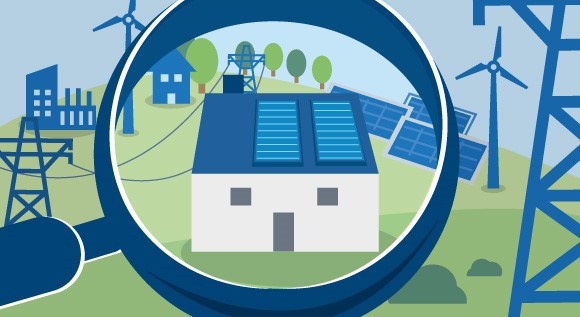What exactly is “solar thermal energy”?
Everybody knows that the sun gives off heat. But how do we use solar energy to heat up water for our central heating system or generate heat to run industrial processes? The answer can be found below.
 © BMWi
© BMWiIt’s about generating heat from the sun
When you turn off the tap after watering your garden, some water will remain in the hose. And if the sun is shining, this water will warm up very quickly. But can we use solar radiation to heat up the water in our bathtub as well? The answer is yes. However, the rays of the sun coming in through your bathroom window will not do the trick. What you need is a solar thermal energy system. This system uses the sun’s abundant energy to heat up water so you can take a bath, wash your clothes or fire up your central heating system. It is therefore particularly climate-friendly.
A collector is used to evaporate fluid
This is how a solar thermal energy system works: A tube collector (which is different from a photovoltaic panel that generates only electricity) is installed on a surface exposed to sunlight, for example on a rooftop. The tubes of the collector hold a heat transfer fluid, usually water or a propylene glycol-water mixture, depending on the type of collector used. When the sun heats up the tubes, the fluid evaporates, steam rises up and transfers its heat to a storage unit. The fluid cools down again, flows back down where it came from, and the process starts all over again. The storage unit absorbs the heat and releases it when it is needed – for example when you want to enjoy a nice bath.
A typical solar thermal installation that provides sufficient heat and hot water for a single-family home usually requires a roof space of seven to twelve square meters. It covers up to 30 per cent of the family's annual heating needs. In summer, the solar thermal installation provides sufficient energy to cover the home’s complete heating needs. When it gets colder, a conventional boiler needs to be used to fully heat up the water after it has been preheated by the collector.
Heat for industrial processes
Small solar thermal installations can store heat only for a few days. In order to be able to use heat generated in summer all throughout the winter season, big storage units need to be employed. High-performance solar thermal installations can be used in industry. They are not only used for preparing industrial and heating water, but also for generating heat for industrial processes, also called process heat.
Solar thermal power stations that are set up in particularly sunny regions such as Southern Europe and Africa, combine heat and electricity generation. First, the sun’s energy is used to heat up a fluid (heat), which then powers a conventional turbine (electricity). These facilities can be used to generate electricity only or they can be used for combined heat and power generation.
Using solar energy to cool rooms – not as crazy as it sounds
As paradoxical as it may seem, solar energy can also be used to cool or dehumidify indoor air. There are several ways of doing this, some of which make use of the cooling effect produced as water evaporates. Back in Roman times, people used this principle to chill their fruits: they put them in humid clay pots and then put them in the sun. The water evaporated and the temperature inside the pots dropped. In modern buildings, the need for cooling is usually greatest when there is a lot of sun, so it is a good idea to use a solar-thermal installation which comes with a cooling system. This can help reduce the need for fossil fuels as conventional air-conditioning systems usually run on electricity.
Grants available for private households and companies
Last year, more than 100,000 new solar thermal systems were installed in Germany. The Federal Ministry for Economic Affairs and Energy provides funding for solar thermal energy as a climate-friendly option under its Market Incentive Programme. Solar thermal installations that provide both heat and hot water can receive at least 2,000 euros. The funding scheme is based on two pillars: The Federal Office for Economic Affairs and Export Control (BAFA) provides investment grants for private households and companies that operate small-scale installations. KfW provides promotional loans and repayment grants for operators of large-scale commercial installations. When a new building is erected, there is a requirement to use renewable energy for generating heat.

